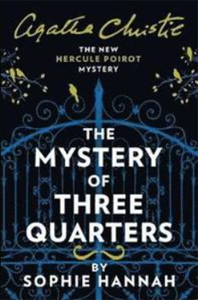Hercule Poirot is known for using his understanding of human psychology to solve murders, and never is this more extreme than in “The Mystery of Three Quarters” (2018), the third of Sophie Hannah’s Christie-estate-commissioned novels.
It’s up to each reader to decide where the line is between “only Poirot could solve this one” and “unsolvable.” “Three Quarters” pushes that line as our favorite Belgian sleuth makes deductions based not only on people’s comments, but also on their tone of voice, facial expressions, the set of their eyes, or a tear rolling down their face.
Drawing conclusions
Poirot assembles accurate accounts of long-ago incidents based on people’s lies, obfuscations and dodging of his questions, combined with unique traits such as an insecure woman’s deep love for her dog. I don’t totally mean this as a criticism of Hannah’s work, as she is a great observer of personality types and the ways traumatic experiences can shape behavior and character. I’m just pointing out that she toes the line of plausibility.

“The Mystery of Three Quarters” (2018)
Author: Sophie Hannah
Series: New Hercule Poirot Mysteries No. 3
Genre: Mystery
Setting: 1929, England
This approach doesn’t replace a thorough explanation and exploration of the clues, though; they work in tandem. Poirot’s two sounding boards on this case are Edward Catchpool – the Scotland Yard inspector who is Poirot’s late-1920s bestie in Hannah’s novels – and Rowland “Rope” McCrodden, a lawyer who staunchly believes in the death penalty.
Hard case McCrodden treats Catchpool rudely on a drive to Combingham Hall, an evocative manor of 40 or so bedrooms where Poirot promises his big reveal of whodunit. As a psychological experiment, Poirot tells McCrodden that his secretary (another person the lawyer treats rudely) has had a terrible accident. McCrodden almost immediately apologizes to Catchpool for treating him rudely.
Hannah illustrates that most people have a sort of internal compass. If they’re feeling ill will toward too many people at one time, they seek to dial it back. Hannah’s books abound with these accurate little observations about human psychology.
Getting into people’s brains
There’s a line somewhere between that and omniscience. But I would argue that mystery novels always have a touch of fantasy that allows me to forgive some excesses. Most notably, someone commits a murder and then goes on to behave normally, until Poirot catches them. In real life, this would be unlikely, but we readers enjoy murder mysteries so much that we forgive this stretch of plausibility.
Hannah likes to maximize what she can get away with right off the bat. “Three Quarters” has a crazy premise: Someone has sent out letters to four people, separately accusing them of the murder of the elderly Barnabas Pandy, who has legally been ruled to have accidentally drowned in his bathtub. These letters are signed with Poirot’s name.
“Three Quarters” is slow to progress as a plot, but Hannah makes up for that with distinct characters and humor (often with the two elements going hand in hand). For instance, one of the accused, school housemaster Hugo, is absurdly forgetful, with his wife bailing him out every day of his life.

Hannah leans into a particular type of Christie humor, with several characters pronouncing Poirot’s name incorrectly. The novel includes a second Christie character, Poirot’s manservant George, whose name is sometimes spelled “Georges” for no apparent reason, mimicking a trait of Christie’s books. I’m guessing this is a purposeful wink.
A confident Poirot
As “Three Quarters” gets underway, a reader shares Poirot’s frustration at having to explain to four people that he did not send the letters; two don’t take his word for it, while two others do. Then Hannah steers our attention toward whether the letter-sender knew all four recipients well.
It’s important to Poirot to know if the letter-sender knew two of the recipients, or three, or four. I never quite grasped why Poirot sensed this is the intellectual path to pursue, when the case is bizarre enough to invite multifold approaches.
Hannah again uses the tried-and-true approach to getting us to read the last 50 pages without a break: Poirot gathers every member of the dramatis personae in one manor drawing room to reveal what happened. She uses the same finale structure in her previous entry, “Closed Casket.”
Poirot explains everything methodically and deliberately, with impatient listeners chipping in to say “Get on with it.” Hannah is winking at the reader over this trope we all love. Here, Poirot (whose thoughts we are privy to via Catchpool’s presence as an after-the-fact omniscient narrator) sets up the gathering before he has figured out whodunit.
The sleuth’s confidence runs high on this particular case, and so does Hannah’s. While “The Mystery of Three Quarters” is not as smoothly plotted as “Closed Casket,” it’s nearly as fun to read. Hannah leans into her own interest in psychology, staying true to her strengths rather than mimicking a legendary author. But the perfect characterization of Poirot and Easter eggs like the mispronunciations make it clear that she knows and loves Christie’s novels.
Sleuthing Sunday reviews an Agatha Christie book or adaptation. Click here to visit our Agatha Christie Zone.

